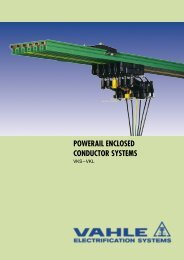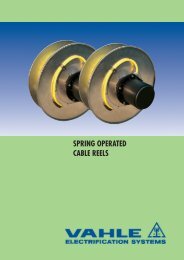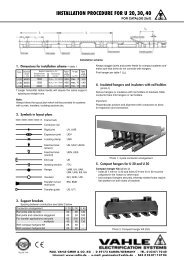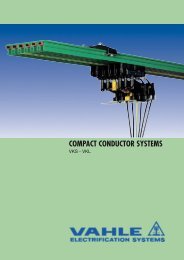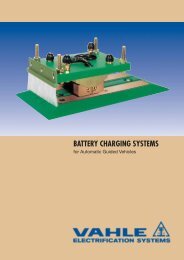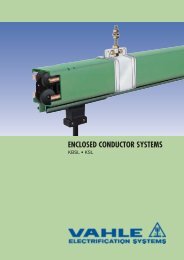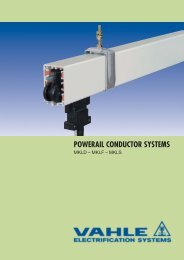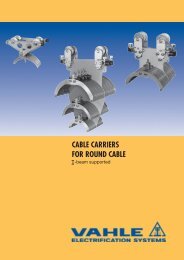Montageanleitung - Wartung VKS 10 Mounting ... - VAHLE, Inc
Montageanleitung - Wartung VKS 10 Mounting ... - VAHLE, Inc
Montageanleitung - Wartung VKS 10 Mounting ... - VAHLE, Inc
- Keine Tags gefunden...
Erfolgreiche ePaper selbst erstellen
Machen Sie aus Ihren PDF Publikationen ein blätterbares Flipbook mit unserer einzigartigen Google optimierten e-Paper Software.
<strong>Montageanleitung</strong> - <strong>Wartung</strong><strong>VKS</strong> <strong>10</strong><strong>Mounting</strong> Instructions - Maintenance<strong>VKS</strong> <strong>10</strong>
<strong>Montageanleitung</strong> <strong>Mounting</strong> instructions<strong>VKS</strong> <strong>10</strong>Sicherheitshinweise . . . . . . . . . . . .3Halteeisen anbringen . . . . . . . . . . .4HRL-Tragprofil anbringen . . . . . . . .4Schleifleitung aufhängen undVerbindungsstoß einstellen . . . . . .5a) Halteeisen . . . . . . . . . . . . . . . . .5b) HRL-Tragprofil . . . . . . . . . . . . . .5Unterlängen . . . . . . . . . . . . . . . . . . .7Biegen der Schleifleitung . . . . . . . .8Endkappen . . . . . . . . . . . . . . . . . . . .8Einspeisungen . . . . . . . . . . . . . . . . .8Streckeneinspeisung VLS . . . . . .8Streckeneinspeisung VNS . . . . . .9Kopfeinspeisung VEKS <strong>10</strong> . . . . . .9Stromabnehmer . . . . . . . . . . . . . . .<strong>10</strong>Stromanschluss herstellen . . . . . .11Einführungstrichter . . . . . . . . . . . .11Schienentrennungen . . . . . . . . . . .12Befestigung derWCS-Laminat-Codeschiene . . . . .12Inbetriebnahme . . . . . . . . . . . . . . .13<strong>Wartung</strong> . . . . . . . . . . . . . . . . . . . . .13Notizen: . . . . . . . . . . . . . . . . . . . . . .14Safety Instructions . . . . . . . . . . . . . .3<strong>Mounting</strong> of support brackets . . . .4<strong>Mounting</strong> of support profile . . . . . .4Installation of the <strong>VKS</strong> conductorrail and splice joint adjustment . . .5a) Support brackets . . . . . . . . . . .5b) Support profile . . . . . . . . . . . . .5Short-lengths . . . . . . . . . . . . . . . . . .7Bending of the powerail . . . . . . . . .8End caps . . . . . . . . . . . . . . . . . . . . . .8Feed terminals . . . . . . . . . . . . . . . . .8Line feed VLS . . . . . . . . . . . . . . . . .8Line feed VNS . . . . . . . . . . . . . . . .9End feed VEKS <strong>10</strong> . . . . . . . . . . . . .9Current collector . . . . . . . . . . . . . .<strong>10</strong>Power connection . . . . . . . . . . . . .11Transfer funnels . . . . . . . . . . . . . . .11Conductor isolators . . . . . . . . . . . .12<strong>Mounting</strong> of theWCS laminate code rail . . . . . . . . .12Commissioning . . . . . . . . . . . . . . .13Maintenance . . . . . . . . . . . . . . . . . .13Notices: . . . . . . . . . . . . . . . . . . . . . .142
<strong>Montageanleitung</strong> <strong>Mounting</strong> instructions<strong>VKS</strong> <strong>10</strong>SicherheitshinweiseWarnhinweise und SymboleFolgende Benennungen und Zeichenwerden in dieser Anleitung für besonderswichtige Angaben benutzt:BVerletzungsgefahrdurchStromschlag!Hier werden Sie auf Situationenhingewiesen, bei denendie Gefahr eines Stromschlagsentstehen könnte.SBeschädigungsgefahr!Hier werden Sie auf Situationenhingewiesen, bei denenStromschienen oder andereAnbauteile beschädigt oderzerstört werden könnten.Die Situationen können die Gefährdungvon Personen, aber auch die Gefährdungvon Gegenständen (z.B. Beschädigungder Stromschienen) nach sich ziehen.HDieHand mit dem ausgestrecktenZeigefinger weist Sieauf Stellen hin, an denen Sieergänzende Hinweise undTipps erhalten.Lesen Sie alle Sicherheitshinweise in dieser<strong>Montageanleitung</strong> sorgfältig und beachtenSie diese bei der Arbeit.BVor Beginn der Montagearbeitenmüssen Sie dieAnlage unbedingt spannungsfreischalten!Bei allen Montagearbeitenmüssen Sie die landesspezifischenVorschriften beachten.Safety InstructionsWarnings and SymbolsThe following denominations and symbolsare used in this manual for particularlyimportant indications:BRisk of injury by electricshock!Here, you are warned of situationswhich may bring aboutthe risk of electric shock.SRiskof damage!Here, you are warned aboutsituations which may result indamage to the conductor railsor other parts of the assembly.These situations may result in danger topersons, but also in damage to equipment(e. g. damage to the conductor rail).HThehand symbol with thestretched index finger indicatestext passages whichprovide you with additional indicationsand tips.Read all safety instructions in this manualcarefully and observe them during thework.BBeforestarting the installationwork, it is mandatorythat you disconnect the plantfrom the mains!Observe the regulationswhich apply to your countryduring the installation work.SQuetschgefahr!Es muss sichergestellt werden,dass durch die Anordnung vonStromschienen/Schleifleitungenund Stromabnehmern/Mitnehmerarmendie Sicherheitsabständezwischen festen und beweglichenAnlageteilen (0,5 m)zur Vermeidung von Quetschgefahrennicht unterschrittenwerden!SRiskof pinching!You must ensure that thearrangement of the conductorsystem provides minimum distances(0.5 m) between fixedand mobile plant parts (i.e. betweenconductor rail, collectortrolleys and towing arms) so asto avoid the risk of pinching!Qualifikation des PersonalsNur entsprechend qualifiziertes Personaldarf mit den Montagearbeiten betrautwerden, also Personen:- die mit Montagearbeiten an dem Produktvertraut sind,Personnel qualificationsOnly such personnel may do installationwork who are qualified as follows:- they shall be familiar with the work relatingto the installation of the product,3
<strong>Montageanleitung</strong> <strong>Mounting</strong> instructions<strong>VKS</strong> <strong>10</strong>- die über die Qualifikation durch Lesenund Verstehen der <strong>Montageanleitung</strong>bzw. durch Einweisung und Ausbildungverfügen,- die die Unfallverhütungsvorschriftenkennen,- die Schulungen in Erster Hilfe erhaltenhaben.- they shall be qualified by reading andunderstanding the installation manualor by instruction and training,- they shall know the hazard preventionregulations,- they shall have received a first aid training.Transport und LagerungBeachten Sie beim Transport der Stromschienendie Gewichtsangaben auf derVerpackung. Lagern Sie die Stromschienenimmer auf einer ebenen Unterlage und vermeidenSie direkte Sonneneinstrahlung.Transport and StorageObserve the weight stated on the packageduring transport and storage of theconductor rails. Always store the conductorrails on an even surface.HMontageder Schleifleitung nurin Innenanlagen.HInstallationof the powerail systemindoors only.HKurvenstückezuerst montieren!Einspeisung in der Nähe desNetzanschlusses einsetzen!Anschlusskabel dürfen dieAusdehnung der Schleifleitungnicht behindern!HInstallcurves and switchesfirst!Position feed set close to theincoming power supply!Connecting cables may notrestrict the free expansionand contraction of thepowerail system!Maximaler Aufhängeabstand <strong>VKS</strong>:in Geraden 1,2 min Bögen 0,6 mMaximaler Aufhängeabstand Tragprofil:an Regalsteher 4,5 man Hilfsstützen 4,0 mMax. Support distance <strong>VKS</strong>:for straight runs 1,2 min curved runs 0,6 mMaximum support distance of supportprofile:at rack support 4,5 mat auxiliary support 4,0 mHalteeisen anbringen<strong>Mounting</strong> of support bracketsDie Halteeisen sind für die Aufnahme der<strong>VKS</strong>-Aufhängungen erforderlich. DieAusführung erfolgt kundenseitig. DerEinsatz von Sonderkonstruktionen istmöglich.The support brackets are required formounting the <strong>VKS</strong> hangers. Supportbrackets are usually installed by the customer.<strong>VAHLE</strong> can suggest and designspecial support arrangements. Bringen Sie die Halteeisen parallelund rechtwinklig zur Fahrschiene an.HRL-Tragprofil anbringen Install the support brackets parallel andat right angles to the conductor rail.<strong>Mounting</strong> of support profileMit dem HRL-Tragprofil kann der Aufhängeabstandvergrößert werden.Die <strong>VKS</strong>-Aufhängungen werden in das Tragprofileingebaut. Das HRL-Tragprofil muss parallel undrechtwinklig zur Fahrschiene angebrachtwerden.With the support profile the support distancecan be extended. The <strong>VKS</strong> hangersare to be mounted to the support profile. Installation of the profile parallel andright-angled to the runway.4
<strong>Montageanleitung</strong> <strong>Mounting</strong> instructions<strong>VKS</strong> <strong>10</strong>G1HSetzendie die erste <strong>VKS</strong>-Aufhängungmax. 300 mm vomTeilstückende.HPlacethe first support at adistance of max. 200 mm fromthe end the conductor railsection.Schleifleitung aufhängen undVerbindungsstoß einstellenInstallation of the <strong>VKS</strong> conductorrail and splice joint adjustment Verlegen Sie die Schleifleitung geradeund parallel zur Kranbahn.HDieSchleifleitung muss anjedem Teilstück mit mind. zweiAufhängungen befestigt werden. Install the conductor rail straight andparallel to the machinery track.HEachconductor rail segmentmust be installed with at leasttwo hangers.1G2G3a) Halteeisen Befestigen Sie die Aufhängungen anden Halteeisen mit Klammern oderSchrauben (G2 oder G3).a) Support brackets Fix hangers to the support bracketswith clamps or screws (G2 or G3).b) HRL-Tragprofilb) Support profile Setzen Sie die Aufhängung in die dafürvorgesehenen Bohrungen desTragprofils (G1). Befestigen Sie die Aufhängungen ander Rückseite des Tragprofils mit denKlammern (G2). Place hangers into the borings of theprofile (G1). Fix hangers with clamps to the backsideof the profile (G2).Die weitere Montage gilt sowohl fürHalteeisen als auch für HRL-Tragprofile.The following installation procedureapplies to both support bracket andsupport profile.1G4HDieWCS-Laminat-Codeschienen-Aufnahme(1) muss beiseitlicher Anordnung immeroben sein (G3 und G4).HWhenthe conductor system islaterally mounted the laminatecode rail (1) must be placed atthe top (G3 und G4).90 mm G5 Setzen Sie das Schleifleitungsstückvon vorne in die Aufhängung und rastenSie dieses anschließend ein (G3). Schrauben Sie das Teilstück an dervorgesehenen Festaufhängung mitder Schraube fest (G4).HJedes Teilstück muss mit einerFestaufhängung ausgeführtsein. Der Abstand zwischenzwei Festaufhängungen darfmax. 6 m betragen.S6 m Längen für eingeschränktenTemperaturbereich∆ T ≥ 50 °C.Einsatzbereich -<strong>10</strong> °C bis+55 °C bei Lieferlänge > 4 mvon -30 °C bis +20 °C beiLieferlänge = 4 m Push the conductor rail section fromthe front into the hanger and lock inplace(G3). Use the screw to bolt down the powerailsection at the fixpoint hangers(G4).HEachS6section must have afixpoint hanger. The distancebetween two fixpoint hangersmay be 6 m max.m lengths for reduced temperaturerange ∆ T ≥ 50 °CRange of application -<strong>10</strong> °Cup to +55 °C for supply lengths> 4 m from -30 °C up to +20 °Cfor supply length = 4 m5
<strong>Montageanleitung</strong> <strong>Mounting</strong> instructions<strong>VKS</strong> <strong>10</strong>G6 Schieben Sie an dem Teilstück dieSteckverbinder mit einem gleichmäßigenÜberstand von 90 mm in dieStromschienenprofile ein (G5).HDieSBeschädigungsgefahrFedern des Steckverbindersmüssen beim Einschiebenzur Wölbung des Stromschienenprofilszeigen.für dieStromschiene!Die Zuordnung der Steckverbindererfolgt nach (G6 undTabelle T1). Schieben Sie die Verbinder-Abdeckkappeeinseitig bis zum Anschlag aufdas Teilstück auf. Push the connecting pegs into thecopper conductors; they shouldevenly protrude 90 mm (G5).HTheSRisksprings of the connectingpegsmust point towards therounding of the copper conductorprofile.of damage to the conductorrail!The assignment of the connectingpegs as shown with (G6 andTable T1). Push the splice joint cap onto theconductor section until the stop positionisreached.Tabelle T1 / Table T1Tabelle Zuordnung SteckverbinderTable allocation plug-in joints<strong>10</strong>-<strong>10</strong>0 A (Kupfer)<strong>10</strong>-<strong>10</strong>0 A (copper)120-140 A (Kupfer)120-140 A (copper)<strong>VKS</strong> <strong>10</strong>- 6/ 60 L1; L2; L3; PE; 1;2 –<strong>VKS</strong> <strong>10</strong>- 6/<strong>10</strong>0 L1; L2; L3; PE; 1;2 –<strong>VKS</strong> <strong>10</strong>- 6/120 PE; 1;2 L1; L2; L3<strong>VKS</strong> <strong>10</strong>- 6/140 PE; 1;2 L1; L2; L3<strong>VKS</strong> <strong>10</strong>- 7/ 60 L1; L2; L3: PE; 1; 2; 3<strong>VKS</strong> <strong>10</strong>- 7/<strong>10</strong>0 L1; L2; L3: PE; 1; 2; 3<strong>VKS</strong> <strong>10</strong>- 7/120 PE; 1; 2; 3 L1; L2; L3<strong>VKS</strong> <strong>10</strong>- 7/140 PE; 1; 2; 3 L1; L2; L3<strong>VKS</strong> <strong>10</strong>- 8/ 60 L1; L2; L3: PE; 1; 2; 3; 4 –<strong>VKS</strong> <strong>10</strong>- 8/<strong>10</strong>0 L1; L2; L3: PE; 1; 2; 3; 4 –<strong>VKS</strong> <strong>10</strong>- 8/120 PE: 1; 2 ; 3; 4 L1; L2; L3<strong>VKS</strong> <strong>10</strong>- 8/140 PE; 1; 2; 3; 4<strong>VKS</strong> <strong>10</strong>- 9/ 60 L1; L2; L3; PE; 1; 2; 3; 4; 5 –<strong>VKS</strong> <strong>10</strong>- 9/<strong>10</strong>0 L1; L2; L3: PE; 1; 2; 3; 4; 5 –<strong>VKS</strong> <strong>10</strong>- 9/120 PE; 1; 2; 3; 4; 5 L1; L2; L3<strong>VKS</strong> <strong>10</strong>- 9/140 PE; 1; 2; 3; 4; 5 L1; L2; L3<strong>VKS</strong> <strong>10</strong>- 9/200 * 2 x L1; 2 x L2; 2 x L3; PE; 1; 2<strong>VKS</strong> <strong>10</strong>- 9/240 * 1; 2 2 x L1; 2 x L2; 2 x L3; PE<strong>VKS</strong> <strong>10</strong>- 9/280 * 1; 2; 2 x L1; 2 x L2; 2 x L3; PE<strong>VKS</strong> <strong>10</strong>-<strong>10</strong>/ 60 L1; L2; L3; PE; 1; 2; 3; 4; 5; 6 –<strong>VKS</strong> <strong>10</strong>-<strong>10</strong>/<strong>10</strong>0 L1; L2; L3; PE; 1; 2; 3; 4; 5; 6 –<strong>VKS</strong> <strong>10</strong>-<strong>10</strong>/120 PE; 1; 2; 3; 4; 5; 6 L1; L2; L3<strong>VKS</strong> <strong>10</strong>-<strong>10</strong>/140 PE; 1; 2; 3; 4; 5; 6 L1; L2; L3<strong>VKS</strong> <strong>10</strong>-<strong>10</strong>/200 * 2 x L1; 2 x L2; 2 x L3; PE; 1; 2; 3<strong>VKS</strong> <strong>10</strong>-<strong>10</strong>/240 * 1; 2; 3 2 x L1; 2 x L2; 2 x L3; PE<strong>VKS</strong> <strong>10</strong>-<strong>10</strong>/280 * 1; 2; 3 2 x L1; 2 x L2; 2 x L3; PE* Parallel geschaltete Stromschienen* Conductors connected in parallel.6
<strong>Montageanleitung</strong> <strong>Mounting</strong> instructions<strong>VKS</strong> <strong>10</strong>AG7 Setzen Sie nun das nächste Teilstückebenfalls von vorne in die Aufhängungund rasten es ein. Schieben Sie die beiden Teilstückezusammen, bis die Steckverbindereinfädeln. Decken Sie hierzu das freieEnde der Schleifleitung mit einemSchlagschutz ab und treiben Sie dieTeilstücke durch Hammerschläge aufdas Einstellmaß „A“ (Tabelle T2)zusammen (G7). Now place the adjoining section fromthe front into the hanger and lock it inthere. Push the two conductor sections together.Cover the free end of the conductorsection with a wooden blockand drive the sections together with ahammer until dimension "A" as pertable (T2 and G7) is reached.G8HUmeine einfache Montage zuerreichen, kann bei Einsatz imHRL Tragprofil ein Montagewerkzeugfür den Verbinderstoßeingesetzt werden.HThemounting tool facilitatesthe installation of support profilejoints.Tabelle T2 / Table T2Montagetemperatur in °C<strong>Mounting</strong> temperature in °C Schieben Sie den Kunststoffklotzüber die Kupferenden. Setzen Siedann das Montagewerkzeug in dieLanglöcher des HRL-Tragprofils einund schieben Sie dieses Teilstückgegen das andere Teilstück (G8). Push plastic block on copper ends.Place mounting tool in slotted holesof the support profile and push thesection against the other (G8).-<strong>10</strong> 0 <strong>10</strong> 20 30 40Luftspalt „A“ in mmAir gap ,,A“ in mm 5 4 3 2 1 0 Richten Sie die Verbinderkappe mitdem Montagehilfswerkzeug, welchesdie Kappe einwandfrei über den Stoßsetzt, optimal aus (G9).HAchten Sie bitte auf einwandfreiesEinfädeln der Steckverbinder.Align the joint cap with an angiliarytool that places the cap perfectly overthe joint (G9).HEnsurethat the connectors aremating in correctly.G9HDieEinstellmaße nach TabelleT2 müssen nur dann genaueingehalten werden, wenn derfür die Schleifleitung max.Temperaturbereich (-<strong>10</strong> °C bis+ 40 °C) zu erwarten ist.Bei geringeren Temperaturdifferenzen( t 20 °C) kann zurVereinfachung der Montagedie Schleifleitung so zusammengeschobenwerden, dassein geschlossener Kupferstoßentsteht. Der Luftspalt an denIsoliergehäusen stellt sichdabei selbständig ein.HTheadjustment dimensions accordingto Table T2 must onlybe observed precisely if the max.temperature range (-<strong>10</strong> °C to+ 40 °C) stipulated for the conductorrail is to be expected.In the case of lower temperaturedifferences ( t 20 °C),in order to simplify installation,the copper conductors can bepushed together such that aclosed copper joint is created.The air gap on the insulatinghousings adjusts itself automatically. Montieren Sie die nachfolgenden Teilstückeauf die gleiche Art.HDerlichte Abstand der Aufhängeklammernzu den Verbinderkappen,Einspeisungen usw.muss mindestens 50 mm betragen,um die Ausdehnungnicht zu behindern. Install the subsequent sections in thesame way.HThe distance between hangersand the connector caps, feedterminals etc. must be at least50 mm so as not to obstructexpansion.7
<strong>Montageanleitung</strong> <strong>Mounting</strong> instructions<strong>VKS</strong> <strong>10</strong>G<strong>10</strong>UnterlängenShort-lengths1G11Wir fertigen die Unterlängen nach Ihren Angabenim Werk. Falls Unterlängen auf derBaustelle noch angepasst werden müssen,bearbeiten Sie die Schleifleitung wie folgt.HDie linke Seite der Stromschienenist werkseitig aufgeweitet,um ein Verschieben im Kunststoffgehäusezu verhindern.Kürzen Sie deshalb immer nurdie rechte Seite. Die Ziffer 1 inG<strong>10</strong>-G11 kennzeichnet dieWCS-Aufnahme.We manufacture short-lengths accordingto customer`s specifications in our factory.If short-lengths still need to be adaptedon site, proceed as follows.HThecopper conductors areanchored at the left side of thePVC housing. Therefore alwaysmake cut at the right hand sideof a section. The numeral 1 inG<strong>10</strong>-G11 designates the WCSmounting.B1G12B Schieben Sie die Stromschienen ander rechten Seite mit einem Holzbrettbis zum bündigen Anschlag am Isoliergehäuseein. Zeichnen Sie die neue Teilstücklängerechtwinklig ein (G<strong>10</strong>). Sägen Sie die Schleifleitung an derMarkierung ab (G11). Schieben Sie nun die Stromschienesoweit zurück, bis beidseitig der gleicheÜberstand ,,B“ erreicht ist (G12). Entgraten Sie die gekürzten Stromschienenenden,sowie das Isolierprofil. Use a wooden block to push the copperconductors on the right-handside until they are flush with the PVChousing. Mark the section to be cut perpendicular(right angle) (G<strong>10</strong>). Use a fine tooth saw to cut the conductorrail (G11). Now push back the copper conductoruntil it extends equally on bothsides of the PVC housing ,,B’’ (G12). Deburr the shortened copper conductorends and the isolating-profile.Biegen der SchleifleitungBending of the powerailG13Die Schleifleitungen werden grundsätzlichnur werkseitig gebogen. Der Mindestradiusfür Innen- und Außenbögenbeträgt R = <strong>10</strong>00 mmThe curves are generally bent in our factory.The minimum bending radius for innerand outer curves is R = <strong>10</strong>00 mmEndkappenEnd capsEndkappen bilden den berührungsgeschütztenAbschluss der Schleifleitung.The end caps terminate the conductorrail and prevent accidental contact.G14 Stecken Sie zuerst die Kriechwegverlängerungauf die Enden (G13). Schieben Sie die Endkappen auf dieSchleifleitungsenden auf (G14).HDieVerschraubung der Endkappenerfolgt von der Stromschienenseitedurch die vorgelochtenBohrungen. Beachten Sie dieKennzeichnungen für rechts (R)und links (L) auf der Endkappe. First place the creepage path extensiononto the ends (G13). Push the end caps on the conductorrail ends (G14).HFixingof the end caps from theconductor side using the preparedborings. Consider mark ofthe right (R) and left (L) hand versionof the end cap.G15 Verschrauben Sie die Endkappen mitder Schleifleitung (G15). Die Schraubensind in der Verpackungseinheitenthalten.HDer Überhang zur ersten bzw.letzten Aufhängung darf max.300 mm betragen (G16). Screw the end caps to the powerail(G15). The screws are included in thepacking unit.HTheextension beyond the firstor last hanger may not exceed300 mm (G16).8
<strong>Montageanleitung</strong> <strong>Mounting</strong> instructions<strong>VKS</strong> <strong>10</strong>max. 300 mmG16EinspeisungenFeed terminalsHDieStreckeneinspeisungensind vorzugsweise auf einem1 m Schleifleitungsstück montiert.HMountline feeds preferably ona 1 m section.G17 Setzen Sie die Einspeisung möglichstin die Nähe der Zuleitung.Um an die Einspeisung zu gelangen wirddas HRL-Tragprofil in diesem Bereich um600 mm ausgenommen. Falls derSteher-,Stützabstand > 3 m beträgt,muss zusätzlich eine Hilfsstütze gesetztwerden (siehe Verlegungsplan).Streckeneinspeisung VLS Demontieren Sie die Abdeckkappe ander montierten Streckeneinspeisung. Setzen Sie die Anschlussleitung nachErfordernis auf Einzeladerlänge ab. Bringen Sie die Kabelschuhe an denEinzeladern an. Setzen Sie die Anschlussbolzen undDistanzstücke in die dafür vorbereitetenBohrungen der Schleifleitung. Schrauben Sie die Kabelschuhe mitden Sechskantschrauben (M 6),Federscheiben und Sechskantmutternan die Anschlussbolzen (G17). If at all possible, place the feed terminalin the proximity of the supply cable.Cut support profile by 600 mm to connectthe line feed. An additioanl auxiliarysupport is required if the distance betweenrack supports exceeds 3 m (seelayout plan).Line feed VLS Remove the cover cap from the installedline feed. Strip and cut the individual wires as require. Install cable lugs to the single wires. Insert connection bolts with spacersinto prepared conductor rail. Bolt the cable lugs, using the hexagonalbolts (M 6), spring washers, andhexagon nuts, onto the terminalstuds (G17).HAnzugsmomentM 6 = 5 Nm.Kabelausgang standardmäßiglinks; rechts auch möglich.HTorqueM 6 = 5 NmCable entry left is standard, cableentry right is also possible.clickclickG18 Setzen Sie die Abdeckkappe auf dieSchleifleitung und achten auf den Kabeldurchgang(G18). Der Kabelausgang erfolgt seitlich(links oder rechts) vom Kabelanschluss.Die Anschlussleitungen für dieVLS-Streckeneinspeisungen könnenauch vormontiert geliefert werden(vorzugsweise GummischlauchleitungHO7RN-F / H07V - K). Place the cover cap over line feedterminals and watch wire routing(G18). Cable entry is either side (left or right)from the cable connection.The connecting cables for the line feedVLS can be supplied as well preassembled(preferebly neoprene cablesHO7RN-F / H07V - K).Streckeneinspeisung VNSLine feed VNSG19 Öffnen Sie den Deckel an der montiertenStreckeneinspeisung. Setzen Sie die Anschlussleitung nachErfordernis auf Einzeladerlänge ab. Bringen Sie die Kabelschuhe an denEinzeladern an und führen Sie dieAnschlussleitung durch die Kabelverschraubung. Schrauben Sie die Kabelschuhe mitden Sechskantschrauben (M<strong>10</strong>; M5),Fächerscheiben und Sechskantmutternan die Anschlussfahnen (G19). Open the cover of the preassembledline feed. Strip and cut the individual wires asrequired. Install cable lugs to the single wiresand put connecting cable through thecable gland. Bold the cable lugs, using the hexagonalbolts (M<strong>10</strong>; M5), spring washersand hexagon nuts into the terminalstuds (G19).9
<strong>Montageanleitung</strong> <strong>Mounting</strong> instructions<strong>VKS</strong> <strong>10</strong>G20HAnzugsmomentein Anlehnungan die DIN VDE 0220 T2M <strong>10</strong> = 44 NmM 5 = 5 Nm.HTorquein accordance toDIN VDE 0220 T2M <strong>10</strong> = 44 NmM 5 = 5 Nm.G21G22G23 Ziehen Sie die Kabelverschraubungsoweit an, bis eine Abdichtung zurAnschlussleitung erfolgt (G20). Setzen Sie den Deckel auf und verschließenSie den Anschlusskasten(G21).Kopfeinspeisung VEKS <strong>10</strong>Die Kopfeinspeisung besteht aus einemAnschlusskasten und der VLS-Einspeisung(siehe VLS-Einspeisung). Schieben Sie die Kopfeinspeisungnach Wahl links oder rechts auf einSchleifleitungsende der VLS-Strecken–einspeisung (G22) und fixieren Sie denKasten mit zwei Schrauben (G23). DieSchrauben sind in der Verpackungseinheitenthalten. Ziehen Sie dann die Kabel durch dasIsolierprofil und die Kabelverschraubung.HBeachtenSie die Kennzeichnungfür rechts (R) und links (L). Ziehen Sie die Kabelverschraubungsoweit an, bis eine Abdichtung zurAnschlussleitung erfolgt (G24). Setzen Sie den Deckel auf und verschließenSie den Anschlusskasten(G25). Setzen Sie die Abdeckkappe auf dieEinspeisung (G26).Stromabnehmer Tighten the cable gland to guaranteea sealing of the cable (G20). Place cover on to the terminal boxand close it (G21).End feed VEKS <strong>10</strong>The end feed consists of a terminal boxand the feeding VLS (please refer to linefeed VLS). Push the end feed either to the left orright hand side on a powerail line feedsection VLS (G22) and fix the boxwith two screws (G23). The screwsare included in the packing unit. Push the cable trough the isolatingprofile and cable gland.HConsidermark of the right (R)and left (L) hand version of theend cap. Tighten the cable gland to guaranteea sealing of the cable (G24). Place cover into the terminal box andclose it (G25). Place cover into the feeding (G26).Current collectorG24SBeschädigungsgefahrdurchVerpolung!Achten Sie auf die richtige Polzuordnungdes Stomabnehmers.SRiskof damage trough reversalof phase!Observe the correct pole allocationfor the current collector!G25Halter für StromabnehmerFür die Stromabnehmer muss die Befestigungsflächeparallel zur Längsrichtungder Schleifleitung, sowie rechtwinklig zurSchleiffläche ausgeführt sein. Befestigen Sie die Stromabnehmer inder vorgesehenen Position.Current collector bracketFor the current collector, the mountingbracket must be designed in parallel tothe longitudinal direction of the conductorrail as well as at right angles to thecontact surface. Mount the current collectors at the intendedposition.<strong>10</strong>
123<strong>Montageanleitung</strong> <strong>Mounting</strong> instructions<strong>VKS</strong> <strong>10</strong>G26HDieEinbauhöhe „H“ (S1) entnehmenSie bitte der Tabelle T3.HTheinstallation height "H" (S1)of the current collectors, isshown in table T3.Schieben Sie den Stromabnehmer indie vorgesehene Position. Richten Sie den Stromabnehmer aufPhasenmitte aus. Push the current collector intothe intended position. Align the current collector to the centerof the copper conductor.Tabelle T3/ Table T3Auslenkungen StromabnehmerCollector tolerancesHHub-und seitliche Auslenkung (A)Horizontal and vertical tolerances (A)KST 30 bis KST 55 85 ±20KSTL 30 bis KSTL 55 95 ±30KSTU30 bis KSTU 55 85 ±20KESR32-55- 6-14 88 ±15KESR32-55- 7-14 88 ±15KESR32-55- 8-14 88 ±15KESR32-55- 9-14 88 ±15KESR32-55-<strong>10</strong>-14 88 ±15HHFür den Schutzleiter-Stromabnehmerist der Mitnehmer ent-the ground current collectorHThe carrier is suitably milled forS1sprechend ausgefräst (S1).(S1).HubLiftAAKST, KSTL, KSTUS2 Befestigen Sie den Stromabnehmermit der Befestigungsschelle.HDiefür den Betrieb zulässigenToleranzen ,,T“ für Hub (S2) undAuslenkung (S3) gelten fürStromabnehmer und Schleifleitungim Zusammenhang. Siesollen die Differenzen ausgleichen,die durch Führungsungenauigkeitendes Fahrzeugs undmöglichen Montageversatz derSchleifleitung entstehen. Install the current collector by usingthe collector bracket.HThe permissible tolerances"T" for lift (S2) and swivel (S3)apply commonly for collectorand conductor rail. They areintended to compensate fordifferences resulting fromguiding inaccuracy of the vehicleand possible misalignmentinstallation of the conductorrail.AAAuslenkungSwivelS3 Verlegen Sie den freihängenden Teilder Anschlussleitung mit einem Minimalbiegeradiusvon <strong>10</strong> x Leitungsdurchmesser. Befestigen Sie die Stromabnehmer anden dazu vorgesehenen Mitnahmepunktender beweglichen Verbraucher.SBeschädigungsgefahr für dieStomabnehmer!Die Anschlussleitungen dürfendie Beweglichkeit der Stromabnehmernicht behindern. Install the suspended part of the connectioncable so that its bending radiuswill always be larger than <strong>10</strong>times the cable diameter. Mount the current collectors at the bythe customer designated location.SRiskof damage to thecurrent collector!The connection cable must nothinder collector movementand flexibility in any way.Stromanschluss herstellenPower connectionBVerletzungsgefahrdurchStromschlag!Bevor Sie die elektrische Verbindungherstellen, müssenSie die Anlage spannungslosschalten!BRiskof injury by electricshock!Before you make any electricconnection, make absolutely certainthat the main feed has beendisconnected and locked out.11
<strong>Montageanleitung</strong> <strong>Mounting</strong> instructions<strong>VKS</strong> <strong>10</strong>G27G28Schliessen Sie die Einspeisung an dasStromnetz an (siehe Kapitel Einspeisungen). Verdrahten Sie die Stromabnehmermit den Verbrauchern.SBeschädigungsgefahr durchVerpolung!Achten Sie auf die richtigePolzuordnung.HSchalter,Sicherungen und Kabelzur Verdrahtung sind kundenseitigbereitzustellen undzu montieren.Connect the feed terminal to the mainpower supply (see chapter on feed terminals). Wire the current collectors to theequipment.SRisk of damage due to incorrectphase orientation!Ensure that the phases are assignedcorrectly.HSwitches,fuses, and cablesfor wiring must be providedand installed by the customer.EinführungstrichterTransfer funnelsG29G30Einführungstrichter werden mit einemSchleifleitungsstück ausgeführt. DerEinführungstrichter ist links sowie rechtsan entsprechend vorbereiteten <strong>VKS</strong>-Teilstückenanbaubar.HBeschädigungsgefahr fürdie Stromabnehmer undEinführungstrichter!Im Einfahrbereich der Trichtergelten für die Stromabnehmereingeschränkte Toleranzen fürHub und Auslenkung von max.15 mm in allen Richtungen. DieEinfahrgeschwindigkeit beträgtmax. <strong>10</strong>0 m/min.Transfer funnels are supplied on a powerailsection. The funnel can be mountedon the left or right hand side of preassembled<strong>VKS</strong>-powerail sections.HRiskof damage of collectorsand transfer funnels! . . . . . .Restricted tolerances are validfor the collectors in the area ofthe funnels, i.e.15 mm max.horizontal and vertical movementin each direction. Themax. speed is limited to. <strong>10</strong>0m/min.1G31G32 Montieren Sie die Stütze nach Verlegungsplan. Befestigen Sie das Halteblech an derStütze (G27). Befestigen Sie die HRL-Aufhängungan dem Halteblech (G28). Schrauben Sie das HRL-Tragprofil andie HRL-Aufhängung (G29). Befestigen Sie die Schleifleitung indem HRL-Tragprofil (siehe Kapitel„Schleifleitung aufhängen“) Setzen Sie die drei Aufhängeklammernin die Trichterbohrungen ein (1)und schieben den Trichter auf dasSchleifleitungsstück auf (G30). Befestigen Sie den Einführungstrichtermit den <strong>VKS</strong>-Aufhängeklammernan dem Halteblech (G31). Sichern Sie die Aufhängeklammerndurch die Festpunktschrauben(siehe G4). Richten Sie die Trichtereinheit an derHilfsstütze genau aus und befestigenSie diese (G32).HBeigegenüberliegend angeordnetenEinführungstrichternmuss die Luftstrecke mindestensso groß sein, dass sichdie Stromabnehmer entspannenkönnen. Install the support as per the layoutdrawing. Fasten the support plate to the support(G27). Fasten the hanger to the supportplate (G28). Bolt the support profile to the hanger(G29). Fasten the conductor rail section tothe support hanger (see chapter „Installationof the <strong>VKS</strong> conductor rail“) Insert the three hanger clamps intothe funnel borings (1) and push thefunnel onto the conductor section(G30). Fasten the funnel with the <strong>VKS</strong> hangerclamps to the support plate (G31). Secure the hanger clamps with fixpointscrews (see G4). Align the funnel with the support andfasten it there to.HIftwo transfer funnels are installedfacing each other makesure that the air gap between thefunnels is large enough to allowa passing over of the collector intension released condition.12
<strong>Montageanleitung</strong> <strong>Mounting</strong> instructions<strong>VKS</strong> <strong>10</strong>SchienentrennungenConductor isolatorsMit den Schienentrennungen wird dieSchleifleitung elektrisch getrennt. Der Einbauim <strong>VKS</strong>-Teilstück erfolgt werkseitig.The conductors may be electrically separatedby installing isolators. The isolatorsare installed at the factory.Befestigung der WCS-Laminat-Codeschiene<strong>Mounting</strong> of the WCS laminatecode rail(1)BCBG33G34 Stecken Sie das Kunststoff-Laminatbandin die Nut des Isolierprofils. Verbinden Sie das Isolierprofil mitdem Kunststoff-Laminatband anhandder Befestigungsklammern ausFederstahl (G33).HAchten Sie darauf das die Klammerzuerst in die Nut (1) greift. Setzen Sie das Laminatband an jedemSchleifleitungsteilstück mittigmit einer Schraube fest. Push the laminate code rail into thegroove of the isolating profile. Connect the isolating-profile with thelaminate code rail through the steelclamps(G33).HMake sure the clamp sits properlyin the groove (1). Anchor the laminate code rail with ascrew at each conductor section.Der Befestigungsabstand beträgt 200 mm(Langloch 6,6 x 30 mm im Laminat alle200 mm).Neben dem Wegmesssystem kann auchdas selbstklebende Barcodeband (BCB)auf den Steg aufgeklebt werden (G 34).The support distance is 200 mm (the coderail has slotted holes 6,6 x 30 mm in200 mm centres).Instead of the laminate code rail the adhesivebarcode stripe can be used as well(G 34).MontageabschlussNach Beendigung der Montage ist dieAnlage auf Funktionsfähigkeit zu prüfen.Installation completionOn completion of the installation thesystem must be tested for functionality.InbetriebnahmeFühren Sie nach ordnungsgemäßer Montageeine Probefahrt durch. Hierbei müssenSie folgende Punkte beachten:- erste Fahrt mit geringer Geschwindigkeit,- Schleifkohlen müssen ohne Vibration inder Stromschiene laufen,- Funkenbildung an der Schleifkohle darfnicht auftreten (deutet auf verschmutzteoder oxidierte Schleiffläche hin ->Schleiffläche säubern).CommissioningConduct a test run after the installationhas been completed. The followingpoints must be observed here:- Make initial run at low speed,- The carbon brushes should run in theconductor rail without vibration,- There should not be any sparking at thecarbon brush (indicates that the conductorsurfaces are dirty, oxidized orhave burrs; clean contact surfaceand/or remove burrs).<strong>Wartung</strong>BVor Beginn der <strong>Wartung</strong>sarbeitbeachten Sie bitte die Sicherheitshinweiseauf der Seite 3.MaintenanceBBefore starting any maintenancework, comply with thesafety instructions on page 3.Schleifleitung- Geringe <strong>Wartung</strong> bei normalen Umwelteinflüssenund Beanspruchungen.- Regelmäßige Überprüfung auf Fremdbeschädigung.- Optische Kontrolle alle 4 Wochen, dabeiauf Ausdehnung der Stromschienenund Brandstellen achten.- Schleifkohlenstaub, besonders anTrennstellen entfernen.Conductor rail- Little maintenance is required at normalenvironment and operating conditions.- Regular inspection for any externaldamage.- Visual inspection every four weeks;note any expansions of the conductorsand burns.- Remove carbon brush dust, particularlyfrom isolating sections.13
<strong>Montageanleitung</strong> <strong>Mounting</strong> instructions<strong>VKS</strong> <strong>10</strong>StromabnehmerDie Stromabnehmer müssen alle 2 Monatebzw. nach betrieblichen Erfordernissenkontrolliert werden.a) Mechanische Kontrolle:Beweglichkeit der Gelenke, Lager undDrehbolzen kontrollieren. Untersuchungauf mechanische Schäden.b) Elektrische Kontrolle:Abrieb der Schleifkohlen, festen Sitz allerKontaktschrauben und Kabelbefestigungüberprüfen.Schleifkohlen sind so rechtzeitig zu ersetzen,dass die Fassungen der Schleifkohlennicht die äußeren Kanten derVerbinderkappen berühren.c) Kontaktprüfung:Schleifkohle mittels Federwaage aus derStromschiene herausziehen. Die Kontaktkraftsoll bei ca. 5 N pro Schleifkohlebei der Baureihe KST 30- KST 55 liegen,beim KESR 3,5 N.Current collectorThe current collectors must be checkedevery two months or in accordance withoperational requirements.a) Mechanical check:Check the freedom of movement of thearticulated joints, bearings and pivots.Examine for mechanical damage.b) Electrical check:Check for abrasion of the carbon brushesas well as firm sealing of all contactscrews and cable connections.Carbon brushes must be replaced sufficientlyearly so that the holders of thecarbon brushes will not contact the outsideedges of the joint splice caps.c) Contact pressure testing:Pull the carbon brush out of the conductorrail with a spring scale. The contactforce should be 5 N per carbon brush forthe series KST 30- KST 55, for KESR 3,5 N.14
<strong>Montageanleitung</strong> <strong>Mounting</strong> instructions<strong>VKS</strong> <strong>10</strong>Notizen:Notices:15
<strong>Montageanleitung</strong> zu Katalog Nr.4d 2006<strong>Mounting</strong> instructions for catalog No. 4d 2006MANAGEMENTSYSTEMStromschienenCopperhead Conductor Systems . . . . . . . . . . . . . . . . . . . . . . . . . . . . . . . .1 aBatterieladekontakteBattery Charging Systems . . . . . . . . . . . . . . . . . . . . . . . . . . . . . . . . . . . . . .1 bIsolierte Stromschienen U <strong>10</strong>Insulated Conductor Systems U <strong>10</strong> . . . . . . . . . . . . . . . . . . . . . . . . . . . . . . .2 aIsolierte Stromschienen U 20 - U 30 - U 40Insulated Conductor Systems U 20 - U 30 - U 40 . . . . . . . . . . . . . . . . . . .2 bIsolierte Stromschienen U 15 - U 25 - U 35Insulated Conductor Systems U 15 - U 25 - U 35 . . . . . . . . . . . . . . . . . . . .2 cSicherheits-Schleifleitungen Leichtmetall LSV - LSVGAluminium Enclosed Conductor Systems LSV - LSVG . . . . . . . . . . . . . . .3 aSicherheits-Schleifleitungen Kunststoff KBSL - KSL - KSLT - KSGPVC Enclosed Conductor Systems KBSL - KSL - KSLT - KSG . . . . . . . .4 aSicherheits-Schleifleitungen Kunststoff <strong>VKS</strong> - VKLPVC Enclosed Conductor Systems <strong>VKS</strong> - VKL . . . . . . . . . . . . . . . . . . . . .4 bSicherheits-Schleifleitungen Kunststoff MKLD - MKLF - MKLSPVC Enclosed Conductor System MKLD - MKLF - MKLS . . . . . . . . . . . .4 cSicherheits-Schleifleitungen Kunststoff <strong>VKS</strong> <strong>10</strong>PVC Enclosed Conductor Systems <strong>VKS</strong> <strong>10</strong> . . . . . . . . . . . . . . . . . . . . . . . .4 dSicherheits-Schleifleitungen Kunststoff KBHPVC Enclosed Conductor Systems KBH . . . . . . . . . . . . . . . . . . . . . . . . . . .4eSchleifleitungskanäle, KastenschleifleitungenHeavy Enclosed Conductor Systems . . . . . . . . . . . . . . . . . . . . . . . . . . . . . . .5Fahrdratmaterial und ZubehörTrolley Wire and Accessories . . . . . . . . . . . . . . . . . . . . . . . . . . . . . . . . . . . . .6LeitungstenderCable Tenders . . . . . . . . . . . . . . . . . . . . . . . . . . . . . . . . . . . . . . . . . . . . . . . . .7Leitungswagen und Zubehör für -LaufschieneCable Carriers for -tracks . . . . . . . . . . . . . . . . . . . . . . . . . . . . . . . . . . . .8 aLeitungswagen für Flachleitungen auf -ProfilCable Carriers for Flatform Cable on -beams . . . . . . . . . . . . . . . . . . . .8 bFLeitungswagen für Rundleitungen auf -ProfilCable Carriers for Round Cable on -beams . . . . . . . . . . . . . . . . . . . . .8 bRLeitungswagen und Zubehör für -LaufschieneCable Carriers for -tracks . . . . . . . . . . . . . . . . . . . . . . . . . . . . . . . . . . . . .8 cFlach- und Rundleitungen und ZubehörConductor Cables and Fittings . . . . . . . . . . . . . . . . . . . . . . . . . . . . . . . . . .8 LFeder-LeitungstrommelnSpring Operated Cable Reels . . . . . . . . . . . . . . . . . . . . . . . . . . . . . . . . . . .9 a<strong>VAHLE</strong> POWERCOM ® – digitales Datenübertragungs-System<strong>VAHLE</strong> POWERCOM ® – Data Transmission Systems . . . . . . . . . . . . . . . .9 cCPS ® – berührungslose EnergieübertragungCPS ® – Contactless Power System . . . . . . . . . . . . . . . . . . . . . . . . . . . . . .9 dSMG - digitales Datenübertragungs-SystemSMG - Slotted Microwave Guide . . . . . . . . . . . . . . . . . . . . . . . . . . . . . . . . .9 eWCS – WegmeßsystemWCS – Position-Encoding-System . . . . . . . . . . . . . . . . . . . . . . . . . . . . . . . .9 fMotor-LeitungstrommelnMotor Powered Cable Reels . . . . . . . . . . . . . . . . . . . . . . . . . . . . . . . . . . . . .<strong>10</strong>0306 • Printed in Germany • 2506509 • DS • 2000• 03/2006DQS - zertifiziert nach DIN EN ISO 9001:2000OHSAS 18001 (Reg.-Nr. 003140 QM OH)certified by DQS according to Din EN ISO 9001OHSAS 18001 (Reg. Nr. 003140 QM OH))PAUL <strong>VAHLE</strong> GMBH & CO. KG • D 59172 KAMEN/GERMANY • TEL. (+49) 23 07/70 40Internet: www.vahle.de • e-mail: info@vahle.de • FAX (+49) 23 07/70 44 44




